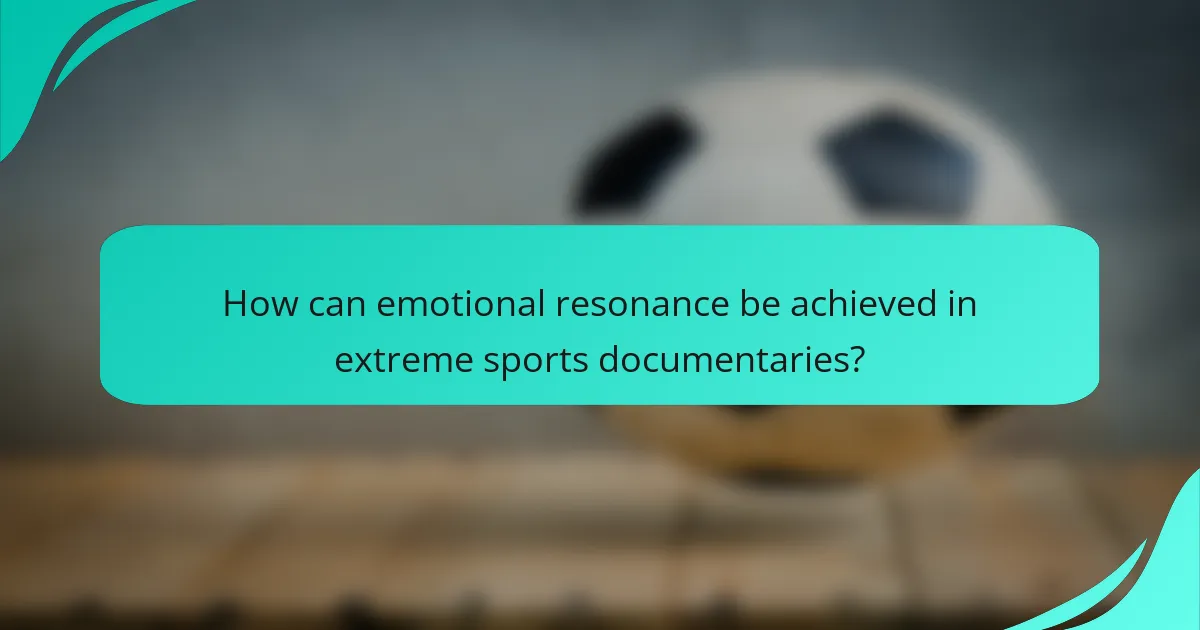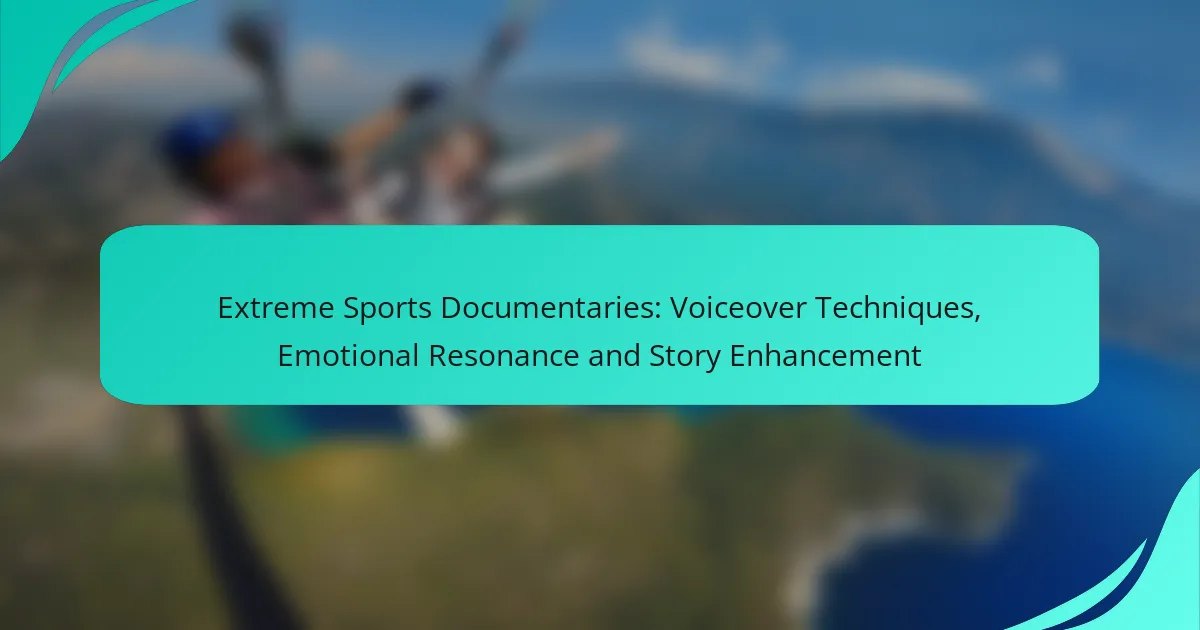Extreme sports documentaries leverage voiceover techniques to enrich storytelling, providing essential context and emotional depth that draws viewers into the athletes’ experiences. By employing distinct voiceover styles, filmmakers enhance the narrative’s intensity and foster a deeper connection between the audience and the athletes. This emotional resonance is further amplified through stunning visuals and carefully curated soundscapes, creating a captivating experience that resonates with viewers on multiple levels.

How do voiceover techniques enhance extreme sports documentaries?
Voiceover techniques significantly enhance extreme sports documentaries by providing context, emotional depth, and narrative cohesion. These techniques help convey the thrill and challenges of extreme sports, making the viewer feel more connected to the athletes and their experiences.
Emotional engagement through storytelling
Storytelling in voiceovers creates an emotional connection between the viewer and the athletes. By sharing personal anecdotes or struggles, voiceovers can evoke empathy and draw the audience into the narrative. For instance, a voiceover that describes an athlete’s journey through injury can resonate deeply, making the viewer invested in their recovery and triumph.
Effective storytelling often includes relatable themes such as perseverance, fear, and triumph. This approach not only captivates the audience but also enhances the overall impact of the documentary.
Creating immersive experiences
Voiceovers can craft immersive experiences by using vivid descriptions and sensory language. This technique allows viewers to visualize the extreme sports environment, whether it’s the sound of crashing waves or the rush of wind during a downhill run. Such details can transport the audience, making them feel as if they are part of the action.
Incorporating ambient sounds alongside the voiceover can further enhance immersion. For example, pairing a voiceover with the roar of a crowd or the sound of equipment can create a more engaging atmosphere.
Building character depth
Voiceovers are essential for developing character depth in extreme sports documentaries. By sharing insights into an athlete’s motivations, fears, and aspirations, voiceovers help the audience understand what drives these individuals. This depth makes the athletes more relatable and memorable.
Including quotes or reflections from the athletes themselves can add authenticity to the narrative. This technique allows viewers to hear directly from the athletes, further enhancing their connection to the story.
Using pacing for dramatic effect
Pacing in voiceovers can significantly influence the emotional tone of a documentary. A slower, deliberate pace can build tension before a critical moment, while a faster pace can convey excitement and urgency during high-action scenes. This strategic use of pacing keeps viewers engaged and heightens the overall impact of the film.
To achieve effective pacing, filmmakers should consider the rhythm of the voiceover in relation to the visuals. Synchronizing the voiceover with key moments in the footage can amplify the drama and create a more compelling viewing experience.

What are the key voiceover styles for extreme sports documentaries?
Extreme sports documentaries often utilize distinct voiceover styles to enhance storytelling and emotional impact. The choice of voiceover style can significantly influence the viewer’s connection to the athletes and the intensity of the sport being showcased.
First-person narrative style
The first-person narrative style immerses viewers in the athlete’s personal experience, allowing them to share their thoughts and emotions directly. This approach creates a sense of intimacy and authenticity, making the audience feel as if they are part of the action.
For example, an athlete might describe their feelings before a big jump or the adrenaline rush during a challenging maneuver. This style can effectively convey the highs and lows of extreme sports, drawing viewers closer to the subject’s journey.
Third-person omniscient style
The third-person omniscient style provides a broader perspective, offering insights into the athlete’s background, motivations, and the context of the sport. This approach allows the narrator to share information that the athlete may not express, enriching the viewer’s understanding of the challenges faced.
Using this style, the voiceover can highlight key moments in the athlete’s career or explain the significance of a particular event. This method can balance personal storytelling with informative commentary, enhancing the overall narrative.
Conversational tone
A conversational tone makes the voiceover feel relatable and engaging, often using informal language and humor. This style can help demystify extreme sports, making them accessible to a wider audience.
For instance, the narrator might share anecdotes or light-hearted commentary during intense sequences, creating a more relaxed viewing experience. This approach can effectively connect with viewers who may not be familiar with the intricacies of the sport while still conveying excitement.

How can emotional resonance be achieved in extreme sports documentaries?
Emotional resonance in extreme sports documentaries can be achieved by connecting viewers to the athletes’ personal journeys, the stunning visuals of their experiences, and the impactful use of music and sound. These elements work together to create a narrative that captivates and engages the audience on a deeper level.
Utilizing personal stories
Personal stories are vital for building emotional connections in extreme sports documentaries. By sharing the backgrounds, motivations, and challenges faced by athletes, filmmakers can create relatable narratives that resonate with viewers. For instance, featuring an athlete’s struggle with fear or injury can evoke empathy and inspire audiences.
Incorporating interviews and candid moments can further enhance these personal stories. Viewers appreciate authenticity, so showcasing raw emotions and personal triumphs can significantly increase the documentary’s impact.
Incorporating powerful visuals
Powerful visuals play a crucial role in conveying the intensity and beauty of extreme sports. High-quality cinematography, including slow-motion shots and aerial views, can immerse viewers in the action and evoke strong emotions. For example, capturing a breathtaking mountain descent or a dramatic wipeout can leave a lasting impression.
Additionally, using contrasting visuals, such as serene landscapes juxtaposed with high-adrenaline action, can amplify emotional responses. Filmmakers should focus on framing and lighting to enhance the visual storytelling, ensuring that each shot contributes to the overall narrative.
Leveraging music and sound design
Music and sound design are essential for enhancing emotional resonance in extreme sports documentaries. A well-chosen soundtrack can elevate the mood, whether it’s an uplifting score during a triumphant moment or a tense piece during a challenging scene. The right music can create a visceral connection with the audience.
Sound design, including ambient sounds and the athletes’ voices, also adds depth to the viewing experience. For example, the sound of wind rushing past during a high-speed run can heighten tension and excitement. Filmmakers should carefully consider how sound complements visuals to create a cohesive emotional journey for viewers.

What are the best practices for selecting voiceover talent?
Selecting voiceover talent for extreme sports documentaries involves identifying voices that resonate emotionally with the audience while enhancing the storytelling. Key practices include choosing relatable voices, assessing vocal range and style, and evaluating previous work in sports to ensure authenticity and engagement.
Choosing relatable voices
Relatable voices can significantly impact the audience’s connection to the documentary. Look for talent that reflects the demographic and emotional tone of the subject matter. For instance, a youthful, energetic voice may suit a documentary about extreme sports enthusiasts, while a more mature voice could lend gravitas to historical perspectives.
Consider conducting audience testing with sample clips to gauge which voices resonate best. This feedback can guide your final selection, ensuring the voice aligns with the intended emotional experience.
Assessing vocal range and style
Vocal range and style are crucial in conveying the right emotions and energy levels. A voiceover artist should be versatile enough to adapt their tone from exhilarating highs during action sequences to reflective lows during personal stories. Listen for clarity, warmth, and the ability to evoke emotion, as these qualities enhance viewer engagement.
When assessing vocal style, consider the pacing and inflection. A voice that can shift seamlessly between excitement and calm can elevate the storytelling, making it more dynamic and compelling.
Evaluating previous work in sports
Reviewing a voiceover artist’s previous work in sports-related projects can provide insight into their suitability. Look for experience in similar genres, as familiarity with sports terminology and culture can enhance authenticity. A voiceover artist who has narrated extreme sports events or documentaries will likely have a better understanding of the nuances involved.
Check for reviews or testimonials from past clients to gauge the artist’s reliability and effectiveness. This can help ensure that the selected talent will deliver a professional performance that aligns with your documentary’s vision.

What role does scriptwriting play in enhancing documentaries?
Scriptwriting is crucial in enhancing documentaries as it shapes the narrative, guides the voiceover, and evokes emotional responses from the audience. A well-crafted script ensures that the story flows logically while maintaining viewer engagement through compelling language and structure.
Structuring the narrative arc
Structuring the narrative arc involves organizing the documentary’s content into a coherent framework that includes a beginning, middle, and end. This structure helps to build tension and emotional resonance, allowing viewers to connect with the story on a deeper level.
Key elements of a strong narrative arc include establishing a clear premise, developing characters or themes, and providing a resolution that ties back to the initial premise. For example, a documentary about extreme sports might start with the thrill of the sport, delve into the challenges faced by athletes, and conclude with their triumphs or lessons learned.
When structuring the narrative, consider pacing and transitions to maintain viewer interest. Avoid abrupt shifts in tone or topic, as these can disrupt the emotional flow and diminish the impact of the story.
